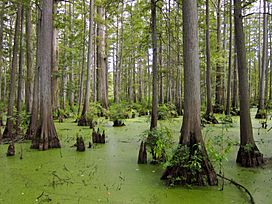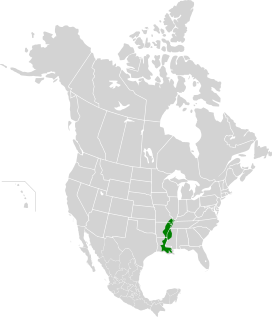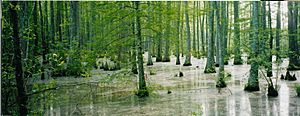Mississippi lowland forests facts for kids
Quick facts for kids Mississippi lowland forests |
|
|---|---|

Cache River State Natural Area, Illinois
|
|
 |
|
| Ecology | |
| Realm | Nearctic |
| Biome | Temperate broadleaf and mixed forest |
| Bird species | 222 |
| Mammal species | 62 |
| Geography | |
| Area | 112,300 km2 (43,400 sq mi) |
| Country | United States |
| Conservation | |
| Habitat loss | 72.508% |
| Protected | 5.21% |
The Mississippi lowland forests are a special type of forest found in the eastern United States. They are known as a temperate broadleaf and mixed forest ecoregion. This means they have a mix of trees that lose their leaves in winter and trees that stay green all year. These forests cover a huge area of about 112,300 square kilometers (43,360 square miles).
Contents
Where are the Mississippi Lowland Forests?
These forests are located along the Mississippi Alluvial Plain. This is a flat area of land created by the Mississippi River. You can find these forests stretching from Louisiana in the south all the way up to the southern part of Illinois.
The original forests here were mostly "bottomland hardwood forests." This means they grew in low-lying areas that often got flooded by the river. This regular flooding helped decide which trees could grow and how fast they grew. In the past, these forests were very thick and covered over 10 million hectares (about 25 million acres). They had trees like cypress, hickory, oak, and cedars. Sadly, most of the original forest along the Mississippi River has now been cleared away. The flat, wet Mississippi floodplain is very different from the higher, drier land around it.
Plants of the Lowland Forests
The forests that are left have a mix of trees. You can find oak, hickory, and pine trees here. There are also many other types of trees, especially in the swampier areas. These include:
- Bald cypress (Taxodium distichum)
- Water tupelo (Nyssa aquatica)
- Black willow (Salix nigra)
- Water hickory (Carya aquatica)
The Mississippi River is very important for these plants. It acts like a highway, carrying seeds and helping these different tree species spread across the region.
Animals of the Lowland Forests
These forests used to be home to many forest animals. One famous bird that lived here was the ivory-billed woodpecker. The Mississippi River is still a very important path for many birds that migrate (travel long distances). Huge numbers of ducks spend their winters here, including:
Other birds you might see in this area include many songbirds, bald eagles, herons, and egrets.
Why are These Forests Important?
These forests do many helpful things for nature and people. They help to:
- Refill groundwater: They soak up rainwater, which then goes into the ground and refills underground water supplies.
- Clean water: They help make the water cleaner by reducing how cloudy it is.
- Control floods: They can slow down floodwaters, which helps protect areas downstream.
These forests also have a very high level of biodiversity. This means they are home to a wide variety of different plants and animals. Some studies suggest that the food chains in these bottomland forests can support two to five times more wildlife species than forests on higher ground. During the winter, the flooded areas of the Mississippi lowland forest provide a home for up to 40% of all the mallard ducks in North America!
Threats and Protecting the Forests

Natural flooding is usually what changes this ecoregion the most. However, efforts to control floods have reduced natural flooding by about 50-90%. This has harmed the homes for many migratory birds.
From the 1940s to the 1970s, large parts of the forest were cleared away. This land was then used for agriculture, especially to grow soybeans. Today, only about 25% of the original forest area is left. In 2002, it was estimated that the region had about 86,938 patches of forest. The average size of these patches was only about 42 hectares (104 acres). Sadly, fewer than 100 of these patches are thought to be big enough to support a healthy group of birds that nest in the forest.
Important Natural Areas in the Ecoregion
The remaining unspoiled woodlands are usually found in the wettest areas. Some of these important places include:
- The Cache River Wetlands in Illinois
- Crowley's Ridge and Mingo National Wildlife Refuge in Missouri
- White River National Wildlife Refuge in Arkansas
- Atchafalaya Basin and Big Woods Conservation Area in Louisiana

